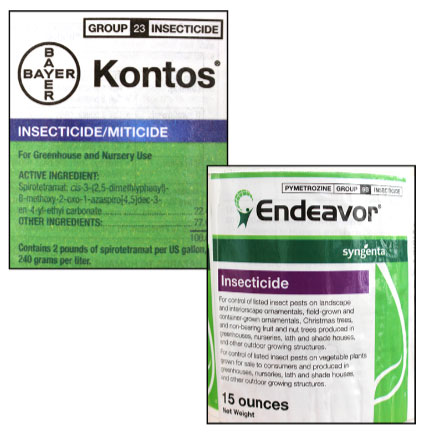8/1/2024
Upward & Downward
Dr. Raymond A. Cloyd
Systemic insecticides are applied to plant leaves as a foliar spray or the growing medium as drenches or granules. When applied to the growing medium, the active ingredient is absorbed by plant roots, and through transpiration, distributed throughout the plant accumulating in the leaves and stems. Systemic insecticides can protect plants from feeding by insect pests with piercing/sucking mouthparts, including aphids, leafhoppers and whiteflies (Figures 1 and 2) that feed in the plant’s vascular tissues, such as the xylem (water conducting) and/or phloem (food conducting).
In addition, systemic insecticides can protect plants from certain species of leaf-feeding beetles, including the red-headed flea beetle (Systena frontalis). Insect pests are killed after ingesting lethal concentrations of the systemic insecticide active ingredient during feeding. Systemic insecticides may protect plants from insect pest feeding damage for up to 10 weeks during the growing season.
Systemic insecticides typically only move upward in the plant. However, there are two systemic insecticides: spirotetramat (Kontos) and pymetrozine (Endeavor) that move upward and downward in the vascular tissues of plants, which means the systemic insecticides move into the leaves, stems and roots. This article discusses the characteristics of spirotetramat and pymetrozine.

Spirotetramat
Spirotetramat is commercially available as Kontos (Envu [formerly Bayer Environmental Science]; Figure 3) for use in greenhouse production systems and labeled for use against aphids and whiteflies. Spirotetramat is more effective in killing the young life stages (larvae or nymphs) than adults. Spirotetramat is in IRAC (Insecticide Resistance Action Committee) group 23 with a mode of action that involves inhibition of acetyl CoA carboxylase by impeding lipid biosynthesis and growth regulation.
Figure 1: Aphids feeding on leaf underside.
Figure 2: Whitefly adults feeding on leaf underside.
In addition, spirotetramat may have growth inhibiting activity by disrupting the molting process although the active ingredient is not an insect growth regulator. Moreover, spirotetramat negatively affects whitefly eggs by breaking down the eggshell (chorion), which is the hard external covering of the egg, causing the eggshell to crack. The water solubility of spirotetramat is 29.9 ppm or 29.9 mg/L. Due to the low water solubility, spirotetramat must be applied before insect pests are present. Once inside the plant, spirotetramat is converted into the metabolite, spirotetramat-enol.

Pymetrozine
Pymetrozine is commercially available as Endeavor (Syngenta Crop Protection; Figure 4) for use in greenhouse production systems and labeled for use against aphids and whiteflies. Pymetrozine is in IRAC group 9B with a mode of action associated with modulating the chordotonal organ TRPV channel or acting as a selective feeding blocker. Pymetrozine inhibits feeding by blocking stylet penetration into the vascular tissues and interfering with neural regulation of fluid intake through the mouthparts. The mode of action prevents ingestion of phloem fluids resulting in starvation and eventual death of insect pests. The mode of action can reduce the transmission of certain plant viruses.
Figure 4: Product containing pymetrozine as the active ingredient.
Figure 3: Product containing spirotetramat as the active ingredient.
Although aphids stop feeding within a few hours after ingesting pymetrozine, they remain alive for two to four days on plants before dying of starvation. Pymetrozine may protect plants from feeding by aphids or whiteflies for up to three weeks. The water solubility of pymetrozine is 290 ppm (290 mg/L). Consequently, like spirotetramat, pymetrozine should be applied before insect pests are present. GT
Dr. Raymond A. Cloyd is a Professor of Extension Specialist in Horticultural Entomology/Plant Protection for Kansas State University. He can be reached (785) 532-4750 and rcloyd@ksu.edu.